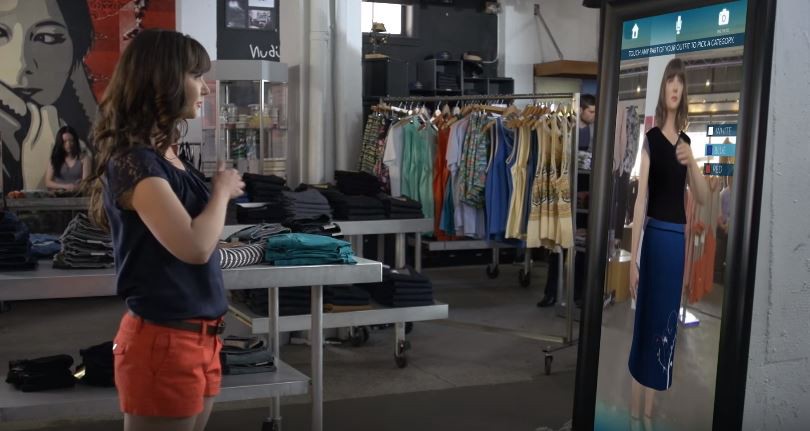Most retailers have been focusing on improving their online presence and rethinking the shopping experience of customers on the internet. Some clothing retailers, however, have decided to rethink the in-store experience and have tried to leverage digital technologies to, again, increase the relevance of brick and mortar stores. Virtual mirrors have been introduced by chains such as Tommy Hilfiger to simplify the process for shoppers.
A shopper brings a piece of clothing in front of a mirror and scans the barcode. The system recognizes the item and overlays the captured image of the user with the item of clothing. The shopper is now shown his virtual appearance with the outfit, which adapts according to his movements. Outfit sizes, colors, and combinations can also be changed with the push of a button. The lighting of the dressing room can be adapted to allow the user to try each combination in different settings. Furthermore, the customer has the opportunity to access the complete inventory catalog of the stores, usually available only to online users. The technology also offers complimentary suggestions to each item, which could increase the customers’ willingness to engage in additional purchases.
The introduction of this technology comes as a response to the challenge that online shoppers face when evaluating the sizes of items.
Retailers can benefit in various ways. Primarily, damage to inventory is reduced as items are only taken out of stock when customers purchase each item. Secondly, stores can use vast amounts of customer data to predict sales based on the levels of engagement. This improves the company’s marketing capabilities as customers can be targeted more reliably.
In my opinion, this technology is a great addition to traditional retail stores as people still enjoy going into stores to be personally consulted and can physically try on each item. This technology, paired with a strong online presence can improve a company’s brand.
https://hackernoon.com/virtual-mirror-the-future-of-interaction-95755b0d3d60


Hi Jannis,
Very interesting post to read! It is definitely an interesting innovation that will have an impact on how we shop in stores. I agree with the points you make about the benefits and would like to add another benefit to the list, namely a decrease in retail store space needed. When customers can “try on” clothes on a virtual mirror, there is no need to have a store and stockroom full of items. A couple of items per size and colour are enough for a store to have in stock and otherwise customers can order it online. Or a specified in the video, create a shopping list and make outfit combinations that customers can order. Needing less big retail store spaces will have an impact on the real estate position in shopping streets. Stores might be split up in multiple smaller stores or fulfill another function, such as a cafe or gym studio.
As the brick and mortar retail lanscape is already changing, it’s very fascinating to see that there are innovations focusing on trying to get the customer to a physical store instead of online. I totally agree with you that this innovation can improve a company’s brand. My only concern is, will it be enough to attract customers to a physical store and will this mirror make a return on investment?
Overall, interesting post!
Cheers, Laura
Thanks for sharing this interesting post! I tried this myself when I was in a Zara store in Barcelona. It was a nice feature to make your shopping experience slightly more convenient, but in my opinion it isn’t really necessary. To me it felt like I was continuously being tracked and attacked with suggestions of other clothing pieces, which I am not interested in.
Nevertheless, for other customers it could decrease the unpleasant side effects of offline shopping in the fitting rooms. Often being packed, warm, dusty and having poor lighting being the common complaints. On the other side of the spectrum – while shopping online – people put things in their cart and never check out, or they buy it in five different sizes knowing you cannot try on your items until you have already made the purchase and received them. Consequently, not all different sizes will be kept, meaning they will have to return some and wait to be refunded.
Related to the challenge of online shopper, nowadays there are more and more apps and clothing websites offering services using Augmented Reality which allow you to try on clothes online. Essentially, bringing the dressing room into your home. This saves a lot of hassle for the customers, but is also very beneficial for the retailers who will have decreased co2 emission, because of smaller orders and decreased returning items. Even though, this is still rather new and upcoming, it is interesting to keep an eye on as it keep eventually again diminish the importance of brick and mortar stores.
I really like the subject of your blog post, as it explains the use of technology by (luxury) retailers like Tommy Hilfiger differently from other blog posts. I think the strongest part of your post is that you highlight that the technology is a great addition to improve the offline customer journey, but that this must go hand in hand with a strong online presence. This last sentence really brings the right nuance; exactly, this is also what the authors of the article ‘Luxury shopping in the digital age’ (2014) by McKinsey explained. As online (luxury) sales grow way faster than the overall sales of (luxury) good, creating a more seamless offline shopping experience in addition to this strong online presence, it will eventually lead to more in-store purchases.